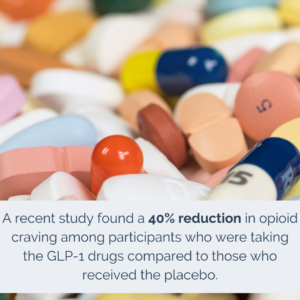From Weight Loss to Substance Abuse: A Multi-Billion Dollar Oversight?
Obesity and the chronic diseases associated with it are estimated to have had an economic and workforce impact of over $425 billion just in the US in 2023. Ozempic and other GLP-1s, a powerful new class of weight loss medications, are projected to boost US economic output by $1 trillion in just a few years by improving health and increasing productivity. While some industries may experience disruption from this Ozempic boom, others are poised to grow considerably, potentially yielding even greater economic outcomes.
Beyond weight loss, GLP-1s also show promise in treating substance abuse disorders (SUD)/addiction, which is estimated to have had an economic and workforce impact nearly 9x that of obesity in the US, making these drugs even more interesting and potentially even more profitable.
Perhaps one of the greatest benefits GLP-1s could provide is the reduction of stigma. People with addictions are often unfairly judged and labeled as lacking willpower and self-control. Being overweight had the same perception, until Ozempic and GLP-1s brought the fact that obesity is a disease out into the mainstream, and now that stigma may be beginning to wane.
While substance abuse is classified as a mental disorder, not a medical condition like obesity, mental health is arguably as hot a topic today as Rx weight loss, thus, coupled with the financial implications, GLP-1 research into health concerns beyond weight loss should conceivably intensify, as should new, possibly highly lucrative pharmaceuticals to aid in treating addiction. But is that the case?

FDA-Approved Medications and the Ongoing Need for Innovation
As of today, the FDA has approved the following for substance use disorders:
- Three drugs for the treatment for alcohol use disorder (AUD) – disulfiram, acamprosate, naltrexone.
- Three drugs for opioid use disorder (OUD) – methadone, buprenorphine, and naltrexone.
- Seven treatments for tobacco addiction – nicotine replacement medicines (the nicotine patch, lozenge, gum, oral inhaler, and nasal spray) and pill medicines (varenicline and bupropion SR).
- There are no FDA approved medications for marijuana or cocaine use disorder.
However, even when medications are available, success rates for achieving long‐term abstinence are modest. Combined with how few new drugs are developed to treat addiction, and the tens of millions of Americans who suffer from some form of substance use disorder, there appears to be abundant need for new, more effective medications.
Why Pharmaceutical Companies May Not be Sold on GLP-1s for Substance Use Disorders
The reasons Novo Nordisk, Eli Lilly (the current pharmaceutical companies behind Ozempic, Wegovy, and Zepbound), and other drug manufacturers may be avoiding developing treatments for addiction disorders are complex, and could include one or more of the following factors (to name just a few):
- GLP-1s are believed to work on reward system related disorders by interfering with the urge or desire for more of something. However, the specific mechanism of action (MOA) of how they do this is still under investigation and may take quite some time to fully understand, then gain approval for the use in addiction treatment.
- People who suffer from addiction disorders, substance abuse in particular, are often believed to have other illnesses, thus making safety concerns that could taint a drugs reputation a very high-risk.
- Drugs that treat addiction disorders have not been big money makers in the past.
- Clinical trials in addiction are more complicated than in other diseases and do not always have a clear path to market,
- Experience in treating neurological disorders may not be a core competency of the manufacturer.
- The current cost and side effects associated with GLP-1 medications could deter both adherence and initial interest in starting treatment.
Therefore, for the time being at least, clinical trials for substance use disorders are primarily sponsored by academic institutions.

Exploring GLP-1s for Addiction: Spotlight on 5 Encouraging Studies
The following researchers appear to be doing work that holds promise in advancing GLP-1s for the treatment of substance use disorders.
Alcohol Use Disorder (AUD)
National Institute on Drug Abuse (NIDA); Semaglutide Therapy for Alcohol Reduction (STAR): A Proof-of-Concept Phase II Clinical Trial
Study aims:
- Determine if semaglutide is safe and tolerable in individuals with AUD, as measured by the frequency/severity of adverse events and the proportion of participants who reach maximum dose,
- Determine if semaglutide reduces alcohol drinking from baseline to endpoint, as measured by total number of standard alcohol-containing drinks consumed per week.
Study is currently recruiting.
Opioid Use Disorder (OUD): Milton S. Hershey Medical Center; Use of a GLP-1R Agonist to Treat Opioid Use Disorder
Study aims:
- Determine if liraglutide (brand name is Saxenda®) can safely and effectively reduce craving for opioids in patients with opioid use disorder, a primary factor contributing to early relapse.
Findings: 40% reduction in opioid craving among participants who were taking the GLP-1 drugs compared to those who received the placebo.

Nicotine Dependence (Tobacco Addition): University of North Carolina, Chapel Hill; Effects of Semaglutide on Nicotine Intake and Smoking Lapse
Study aims:
- Examine the effects of an approved GLP-1 receptor agonist on nicotine intake and reinstatement.
- Provide initial laboratory evidence for the potential efficacy of GLP-1 receptor agonists as adjunctive treatments for smoking cessation.
Study is currently recruiting.
Cannabis Use Disorder (CUD): Wang, W., Volkow, N.D., Berger, N.A. et al. Association of semaglutide with reduced incidence and relapse of cannabis use disorder in real-world populations: a retrospective cohort study. Mol Psychiatry (2024)
Study aims:
- Assess the associations of semaglutide with both incident and recurrent CUD diagnosis compared to non-GLP-1RA anti-obesity or anti-diabetes medications.
Findings: Among patients with a prior history of CUD, semaglutide was associated with a significantly lower risk for recurrent CUD diagnosis (medical encounters for CUD diagnosis) compared with non-GLP-1RA anti-obesity medications for a 12-month follow-up period (13.0% vs. 20.4%; HR: 0.62, 95% CI: 0.46–0.84). Consistent reductions with semaglutide were seen in patients stratified by gender, age group, and race, except in Black patients, with the biggest reduction in men and patients aged >55 years old. A similar lower risk for recurrent CUD was observed in patients with and without T2D.
Cocaine Use Disorder (also CUD): Yale University; GLP-1 Agonism for Blocking Cocaine Euphoria and Self-Administration
Study aims:
- Explore the effects of acute pre-treatment with the glucagon like peptide-1 (GLP-1) agonist, exenatide versus placebo, on the subjective (e.g., euphoric) and behavioral effects (e.g., self-administration) of cocaine in experienced, non-treatment seeking users of the drug.
- Explore the effects of sub-chronic (5-day) treatment with exenatide as compared to placebo on the subjective (e.g., euphoric) and behavioral (self-administration) effects of cocaine in experienced, non-treatment seeking users of the drug.
Findings: Results have not yet been released.
Future Directions and Potential Research Opportunities
Like substance addictions, behavioral, or non-substance addictions (e.g., gambling, shopping, hoarding, sex, work, etc.) are also reward system related disorders that GLP-1s could possibly treat. But, despite the news media hype, no current studies/trials appear to be under way at this time.
Non-Pharmacological Companion Products for Substance Use Disorder
| As the GLP-1 research progresses, science-backed, and often tech-driven addiction recovery companion products are gaining traction, in all likelihood due to the increased focus on mental health in society today.
Below are just a few of the industries catering to those suffering from SUD, as well some of the innovators often overtly marketing to the diverse population of recovering addicts. VNS: the global Vagal Nerve Stimulators market was valued at US$ 681.2 million in 2023 and is anticipated to reach US$ 1137.6 million by 2030, witnessing a CAGR of 7.6% during the forecast period 2024-2030, primarily driven by non‐invasive VNS delivery options.
Nootropics: the global Nootropics market size was evaluated at US$13.86 billion in 2022 and it is projected to surpass around US$ 58.39 billion by 2032, poised to grow at a CAGR of 15.47% during the forecast period 2023 to 2032.
Home Infusion Therapy: the US Home Infusion Therapy market size pumped up to US$16.99 billion in 2023 and is projected to reach US$32.81 billion by 2033, with a 7.3% CAGR through 2033.
Oxygen Therapy: the global Oxygen Therapy market size was valued at US$34.5 billion in 2022 and is expected to grow to US$54.1 billion by 2023 at CAGR of 6.51% from 2023 to 2030. Increasing incidence of chronic respiratory diseases and rising demand for home healthcare are the major drivers of the market.
Behavioral Health: The US Behavioral Health market size is projected to grow from $83.70 billion in 2023 to $115.21 billion by 2030, at a CAGR of 4.7% during the forecast period, fueled by the transition to digital tools.
|
Redefining Addiction as a Mental Health Concern
While no drug is going to be a panacea, and the need for more preclinical studies/clinical trials is evident, a goal for GLP-1 discoveries (and their non-pharmacological companions) should be to help in dismantling the stigma surrounding addiction. Demonstrating how medication and other therapeutics can holistically aid in cessation (along with education, advocacy, and destigmatization efforts), will assist in advancing the understanding that addiction is a mental health disorder, not a moral deficiency. And today’s culture could be ready to accept this type of evolution.
_________________________________________
Interested in learning more about how to differentiate your product or capitalize on the opportunities outlined in this article? Drop us a note at hello@migrationmarketing.com with the subject line: Blog Inquiry.
_________________________________________
About the Author
Carol Maggio is a Senior Consulting Strategist at Migration Marketing. As both a smoker (nicotine dependent) and a workaholic, she has a vested interest in the topic of this post.
The author wishes to thank Sandy Chase for her contributions to this article.

